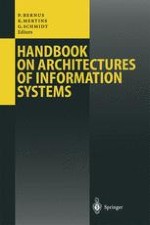This book is the first volume of a running series under the title International Handbooks on Information Systems. The series is edited by Peter Bemus, Jacek Blazewicz, Giinter Schmidt and Mike Shaw. One objective is to give state of the art surveys on selected topics of information systems theory and applications. To this end, a distinguished international group of academics and practitioners are invited to provide a reference source not only for prob lem solvers in business, industry, and government but also for professional researchers and graduate students. It seemed appropriate to start the series with a volume covering some basic aspects about information systems. The focus of the first volume is therefore architectures. It was decided to have a balanced number of con tributions from academia and practitioners. The structure of the material follows a differentiation betweeen modelling languages, tools and method ologies. These are collected into separate parts, allowing the reader of the handbook a better comparison of the contributions. Information systems are a major component of the entire enterprise and the reader will notice that many contributions could just as easily have been included in another volume of the series which is on enterprise integration. Conversely, some traditionally information systems topics, as organisational analysis and strategic change management methods, will be treated in more depth in the Handbook on Enterprise Integration. The two volumes will complement each other.
